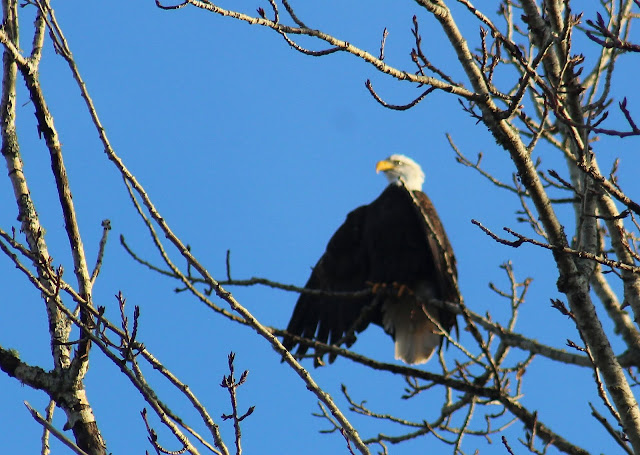I got up with the alarm at 5:45 this morning, and went
out to Nisqually Refuge for the weekly bird walk. The skies were clear, but temperatures were
just at freezing, and frost highlighted the day.
This eagle posed with its wings extended to receive the
warming rays of the rising sun
The standard route took us through the heritage orchard,
where the group had good views of the resident Red-breasted Sapsucker.
 |
| Birders getting "Sapsucker Neck" |
 |
| Richard "Digiscoping" the sapsucker |
I don’t know if frosty weather causes the grasses to put
more sugars or proteins into their leaves, but the Golden-crowned Sparrow flock
spent quite a while grazing on the roadside grasses.
 |
| Grazing Golden-crowned Sparrow |
After leaving the orchard, the path leads around a
service road, then out along the west side of the boardwalk loop toward the
Twin Barns. Here, we watched a Song
Sparrow doing a great imitation of a Nuthatch!
 |
| This is just such an odd posture for a Song Sparrow |
These conks growing on a willow trunk caught my eye. This appears to be a species of Polypore Phellinus
igniarius.
 |
| "Willow Bracket" Phellinus igniarius |
The
fungus causes a condition known as “white rot” which causes the wood to
decay. Woodpeckers know that these trees
will have softer wood in which to burrow nesting holes, or might have
subsequent infestations of ants or beetle larvae.
After a snack stop at the Barns, we ventured
out onto the north dike, separating the estuary marsh from the remaining
freshwater marsh and fields. Here we
have good views of the usual herons and waterfowl
 |
| Obligatory Great Blue Heron photo |
 |
| This Green-winged Teal pair must be going to the Baths to get the mud off their bellies |
 |
| Northern Pintail drake |
 |
| Northern Pintail hen |
At the base of the estuary boardwalk, we saw a
Song Sparrow that was from one of the lighter-plumaged populations.
Shep eBirded it as M.m. montana/merrilli, but
we will submit the observation to the Washington Bird Records Committee folks. It is certainly from a different subspecies
than the usual west coast birds, which are more chocolate-colored.
As we went out onto the estuary boardwalk, the
fog rolled in
 |
| How do you see birds in this? |
The fog lifted here and there to reveal birds
and seals
But, then it would roll back in.
We did get good views of gulls, waterfowl, and
shorebirds
 |
| "Olympic Gull" - Glaucous-winged X Western gull |
 |
| Adult Ring-billed Gull |
 |
| Eurasian Wigeon drake and an American Wigeon hen |
 |
| Least Sandpiper - the world's smallest sandpiper |
With the high tide, I heard a Refuge visitor
say something along the lines of “look at the scum”, presuming that he was
seeing a polluted body of water.
 |
| Diatoms, not "scum" |
In
fact, the floating brown ‘scum’ is an accumulation of diatoms, which are single-celled
algae which have a cell wall of silica.
These algae blooms provide the primary food base for many of the ‘higher’
animals on the mud flats.
Participants on the walk tend to drop out or
move ahead of the volunteer trip leaders, but we had about 8 of the two dozen
continue to the Nisqually River overlook,
and back to the Visitors’ Center
where we began.
 |
| On the way back, we saw a "White Collar" Robin . . . |
As we were tallying the day’s sightings, we
noticed a Red-eared Slider sunning itself along the pond bank. These have to be tough critters to be out on
a January day that barely made it into the 40s.
 |
| Red-eared Slider, Trachemys scripta, is a non-native exotic species |
 |
| The End |
Nisqually eBird Checklist is
Here




























No comments:
Post a Comment